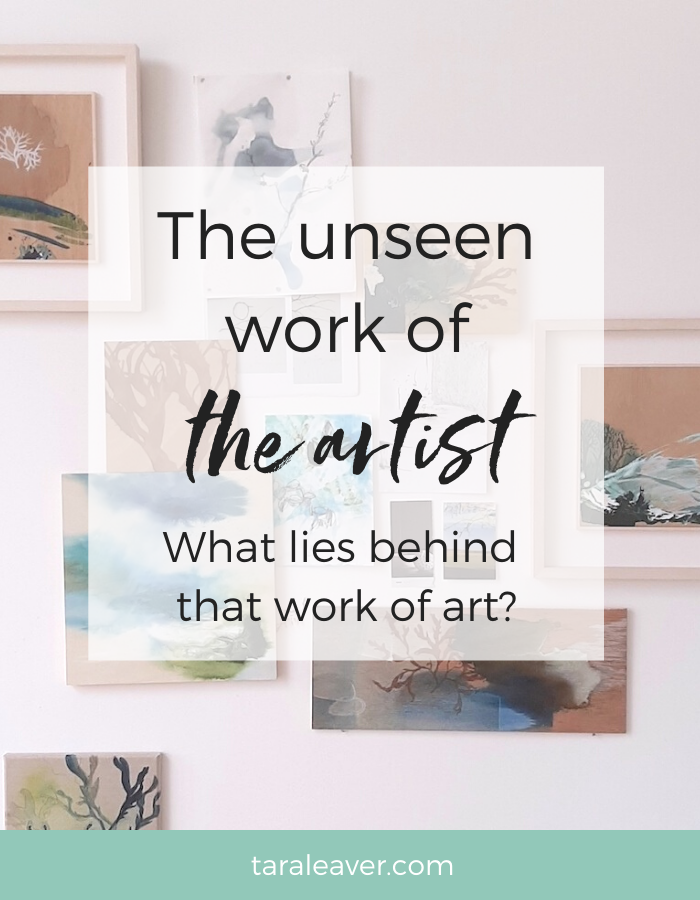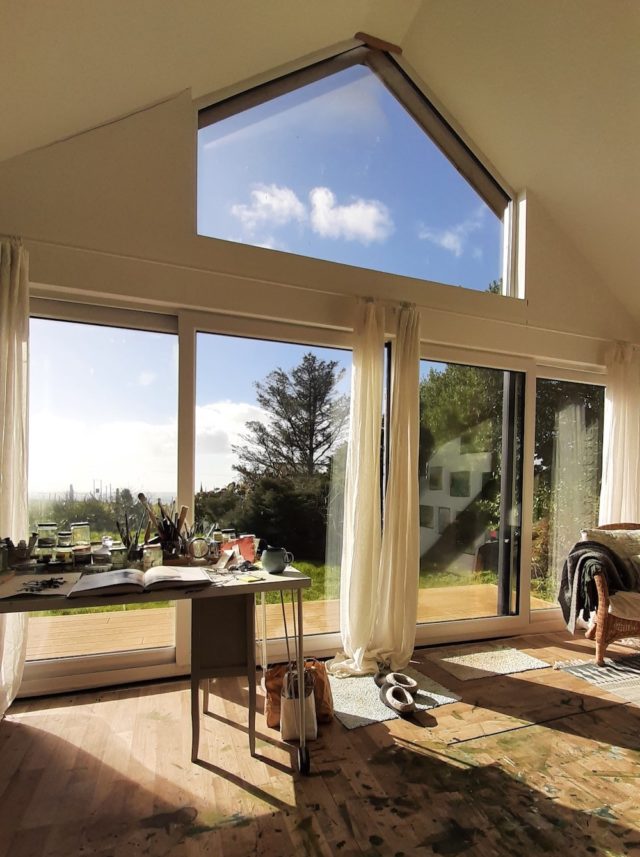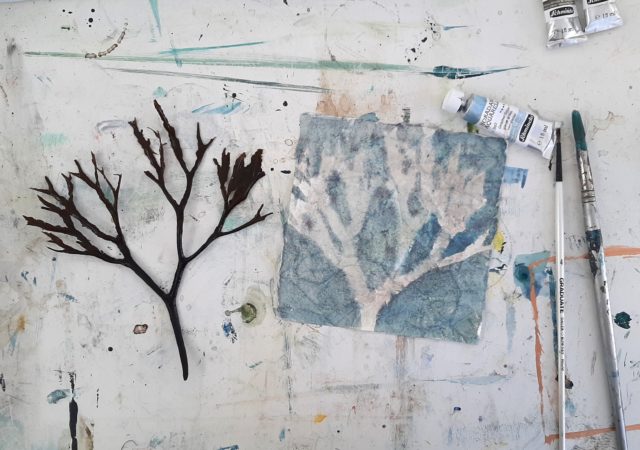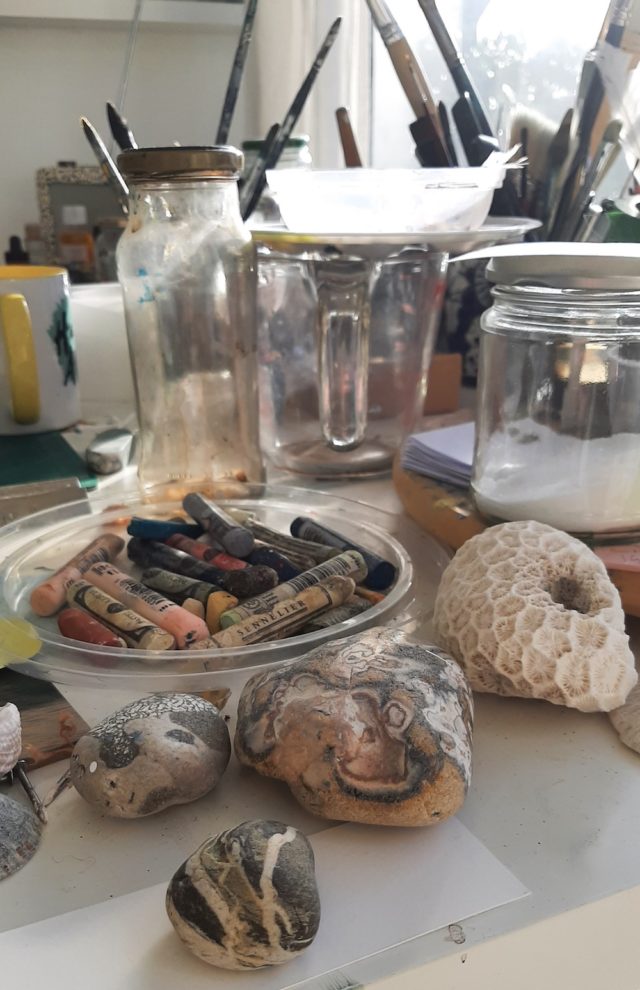
An artist and member of the Happy Artist Studio asked me a while back for some “insight on the amount of ‘unseen work’ behind it all.”
‘It all’ being the life and work of an artist.
I love this question because you just have no idea what’s behind a piece of art unless you’re an artist yourself.
And if you are an artist, it can be very comforting to know that to some degree we all have this invisible world of work behind each finished piece!
The iceberg metaphor is a good one here.
A finished piece of art is the tip of the tip of the iceberg!
David Shrigley calls it ‘the residue of process’ – it’s almost an afterthought, or a side effect, of a much bigger, largely hidden world.
So let’s dig in and see what’s under the surface! I’ll use myself as an example where relevant, so it’s not too abstract.
Learning and Experience
“People ask me how long it took to make a work. I reply by giving them my age.”
Ted Godwin
Whether you have seven degrees and fifty years under your belt, or no formal education and just a year of practice, the bulk of the iceberg consists of your experience as a practicing artist.
And because we’re curious by nature, we’re usually looking to learn more, explore more, discover more, to upgrade the quality of our work and the truthfulness of our self expression.
Learning how to be an artist is something we do every day for our whole lives, once we’ve committed to it, whether we keep it as something we do for pleasure, or develop a business around it.
Even if it’s not something you rely on for income, it’s also not something you switch off from, ever.
Creativity is infinite. There’s always more to learn and discover, even when there’s not always time or money to invest in it!

Mindset
I believe this is the most important part of being an artist, since it can mean the difference between making or not making your art, between thriving or struggling.
It’s also the most invisible, as it all goes on inside, and – like the wind – only its effects can be seen {or not!}.
I talk about mindset all the time in the Happy Artist Studio.
So many #artistproblems can be eased or resolved by shifting our thinking.
We need to be able to be resilient in the face of rejection, determined in the face of perceived failures, patient in the face of slow development, and to cultivate enormous amounts of self trust and kindness to deal with all the demons that can, and will, come up.
In my own experience, my biggest leaps have come from mindset shifts – moments of clarity, reframes that helped me move forward, or a dropping through of something I previously only understood intellectually, and have often spent months or even years ‘working on’.
Annoyingly, you can’t force or control these moments. You can certainly practice new ways of thinking and behaving, and they will create a compound effect, but the real deep shifts happen when they, and you, are ready.
Yes it can take time and sustained effort, but when you’re committed to the higher goal of creative self expression through your art, it’s worth it.

Technology
A sticky area for many artists!
I’m fortunate in that I’ve always loved the technology side of things – up to a point!
I’ve built my own websites for years, and enjoy the kind of mental challenge that using different types of software provides. I find that using the technology exercises a different part of my creativity than painting, and that feels really good to me.
I also get help for the really tricky stuff, which for me is things that involve coding or anything to do with domains and hosting.
A lot of artists don’t feel this way, so if you don’t, you’re in good company!
These days though, you do need the technology, even if only for emailing. You can of course get someone to build and maintain your site, but that then depends on budget, and whether you’re happy to wait for any changes to be made to it.
From creating and maintaining websites, to learning to use social media, to navigating course software if you’re teaching online, to using organising software like Artwork Archive, {this is an affiliate link – I highly recommend!} email providers for your artist newsletters, or spreadsheets to track sales, to name just a few things, it’s unlikely you’ll get away without having to learn and use some aspects of technology.
Logistics
Here are just some of the logistical things I need to organise in my day to day life as a working artist who also teaches:
- studio time {kind of the whole point!}
- packing and shipping work for shows and collectors
- keeping up with emails
- writing Studio Notes and Artnotes
- organising studio visits
- prepping for exhibitions
- updating the website with images or blog posts or new exhibitions and press
- taking paintings to be framed or photographed, then collecting them
- submitting work to competitions and shows
- posting on social media
- marketing both sides of my business
- creating content for the Happy Artist Studio
- supporting members
- customer service/tech issues
… not to mention having a life outside my work!
Being an artist – in particular a self employed artist – takes a lot of thought and planning! You soon learn that running a business is a whole different skillset than making art.
It dismisses romantic notions of artists as floaty and vague; if you want to be a professional artist, you need to wear a lot of different hats, and you need to be ‘on it’.

Communication, Connections, and Relationships
Another challenging area for many artists, especially those of us who identify as introverts, or are shy or experience social anxiety.
From writing and responding to emails, to connecting with gallery owners and other artists, from using social media to building and maintaining relationships with collectors, from studio visits to attending events, and all the different ways to market your work, this side of being an artist can take a lot of mental and emotional energy as well as physical.
If all this is making being a working artist sound hard – well, it can be! Just like any other career. The thing about making art is that no matter what happens, we always have access to a reward that extends beyond any financial gain or public endorsement, or other outward ‘success’.
Getting to make our art is always the ultimate reward.
Yes, there will be professional and personal disappointments along the way, and it can feel like a real struggle to get traction with selling and building your reputation, or reducing that always-there gap between what you want to create and what you’re actually creating.
But we always get to make the work, and I don’t know how many jobs come with that built in bonus.
What’s your experience of the unseen work of the artist? Share your thoughts in the comments!







Thanks for this post Tara. It’s really mind blowing how much work is behind just the smallest painting.
It’s also why many “part-time” artists (bad wording as an artist is a quality and not a job but you get what I mean) struggle to put their art out there. If you invest all your time in order to develop your artistic expression and find your voice you have little to no time for all the other stuff (your list covers a god part of it). If you choose to put your work out there by engaging in social media and taking care of the business side of it (cause if you don’t painting won’t sell themselves) then there’s less time for actual exploration and development.
It’s my conundrum and I’m obviously not alone in this. I just don’t know how to become friends with either one of those choices.
You’re welcome Gina – finally got there! That is such a good point, I hadn’t thought of it that way. I do think that it’s worth focusing on your voice first, until you’ve reached a level of skill and confidence you can stand on, since working it out while trying to sell can cause all sorts of problems! Obviously we’re always growing, but after a certain point it does become easier, and frees up more headspace {and time} to focus on the other side too. There’s definitely some messiness, but then that’s true of life generally; allocating the hours you do have each week to different tasks can help to make sure you’re covering all bases {with lots of flexibility and self kindness for when it sometimes inevitably goes awry!}.